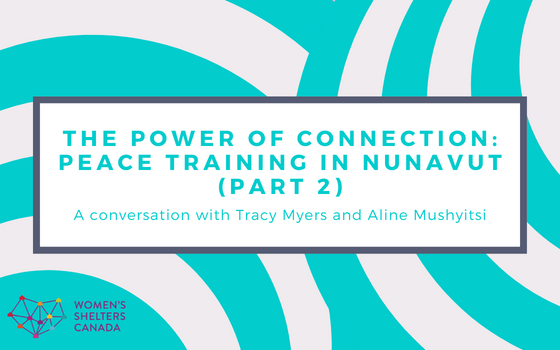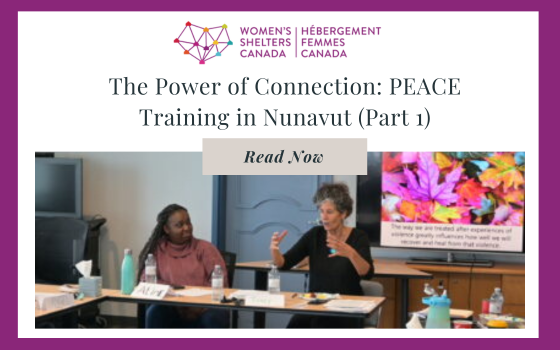On April 6, 2021, three WSC Board members had a virtual discussion to reflect on what the VAW shelter sector has learned after a year of the COVID-19 pandemic, and what it will be carrying forward. Saadia Muzaffar, Public Director and founder of TechGirls Canada, facilitated a conversation between Board Co-Chairs Jo-Anne Dusel (Executive Director of the Provincial Association of Transition Houses and Services of Saskatchewan – PATHS) and Gaëlle Fedida (Coordinator of L’Alliance des maisons d’hébergement de 2e étape pour femmes et enfants victimes de violence conjugale). This is Part 1 of an edited version of that conversation. Part 2 of this blog, Where Do We Go from Here? will be released on Wednesday.
Saadia: Thank you both for joining me today. When COVID-19 hit in March 2020, what were the immediate challenges that shelters across Canada faced?
Gaëlle: The immediate challenge was the fear of the virus, both for shelter staff and the women staying in the shelter. We didn’t have government support to do this, but using my contacts I was able to ensure that all our shelters had proper sanitation protocols in place within a week. In the summer, Public Health saw what we were doing and asked us for those protocols so that they could implement them elsewhere. The lack of government reaction led to a reduction in space within the shelter because some shelters had to, by themselves, create quarantine areas within the shelter should there be an infection inside. This reduced access for women looking for space within shelters.
Jo-Anne: In the first week, there was a lot of scrambling for information. Many shelters already had pandemic plans that were put in place when H1N1 was a concern in 2009. Shelters that did not have those plans in place or their plans hadn’t been updated recently, they really looked to PATHS to support that work to keep clients and staff safe. As Gaëlle said, the government was a little bit late in coming to support shelters in that way. There was so much unknown at that time, and fear of how serious it would be. I give a lot of credit to the shelter directors and staff for moving so quickly and putting those procedures in place. Women’s Shelters Canada and the work it did nationally really helped us to share best practices and brought the level of fear down by helping shelters have solid plans.
Saadia: We know shelters are good at finding creative solutions when faced with challenges. How did the sector respond to COVID-19 to ensure that they could continue to support women and keep them safe?
Gaëlle: There was a lot of adaptation of services to ensure social distancing, so shelters really increased their external and outreach services. For example, counselling by online chat started happening more. During lockdowns, we saw a reduction of demands for physical shelter, though not a reduction in requests for counselling. When things opened up, those calls for shelter increased dramatically. COVID-19, of course, did not solve the space issue we had before; rather, it exacerbated it.
Jo-Anne: I echo everything Gaëlle has said. Some of the ways shelters worked to keep both clients and staff safe were to reduce occupancy within shelters and increase cleaning protocols. Some shelters could set up quarantine spaces for women who were vulnerable to the virus, had been exposed, or were awaiting tests, but this was limited by the physical structure of shelters. Certainly, the use of hotels became very important. While some shelters saw a reduction in calls and others saw an increase, everyone agreed that the calls they were getting were from cases with very serious issues, where the violence was severe and there were also mental health and substance use issues involved. We also noticed a lack of calls from women with children, still to this day. So, it has been a struggle to ensure that women with children feel safe coming to a shelter. I fear that we’re still not reaching everyone who needs shelter.
Saadia: Both of you mentioned the use of technology as an aid to make up for limits in access because of COVID-19. Could you speak to some of the challenges of using technology, and how can we make it more useful going forward?
Gaëlle: It really opened our mind to new ways of serving women. Even before COVID-19, not everyone could physically come to us. It’s an ongoing debate about how to best reach everyone who might need support. This is a new development that, for me, will not turn back. We can now reach women we would not have reached otherwise. It’s always good to have more ways for us to reach women and for them to reach us – to find us, to know we are there, and know we’re capable of supporting them. A shelter is far more than a bed, so these external services really need to be supported, especially when there is a lack of space.
Jo-Anne: I absolutely agree with that. I’ll touch on some of the challenges with using technology. Privacy issues – is an abusive partner likely to be checking your devices and can that increase risk? So, how can we as service providers ensure that the women who are contacting us through technology know about tech safety? For example, using a live chat feature rather than a text thread that could increase their risk of further violence. We really appreciated having the support of other provincial associations, particularly BCSTH; we were able to share their tech safety information with our member agencies. We also saw some closed Facebook groups replace in-person support groups, and those were really good ways for outreach staff to continue working with their clients. I believe we will continue to use these means, particularly with younger people who are more comfortable with this technology.
Saadia: It sounds like there were a lot of changes that were made on the fly to accommodate the needs within the pandemic, in a sector that is often under-resourced compared to demands. How do you think going through this pandemic this will change how shelters operate, besides technology?
Jo-Anne: There have been many things we’ve learned that I think are here to stay. For me, one of the biggest things is envisioning how shelters will look in the future as new facilities are built. Each woman or family should have their own bathroom, which is rarely the case in the current physical structure of domestic violence shelters. Something we haven’t quite figured out yet is how to reach out to people, let them know we’re available, and that they can access our services without physically staying in the shelter.
Gaëlle: Another angle is the relationship with the Ministry of Health. We had the opportunity, with the pandemic, to have an ongoing discussion with them every two weeks. We have developed a closer relationship with those working in the Ministry; we had to work together to solve problems, and that improved the quality of our relationship. I believe this has changed for the better, long-term.
Saadia: Are there other relationships that improved during the pandemic, or are there relationships that should’ve improved, which would help shelter work in the longterm?
Gaëlle: What I said about the Ministry is also true about our own members – within our own associations, we have become closer to our own members as we met weekly or every two weeks during the pandemic. It has consolidated a lot of collective spirit within the provincial associations here. This is something we can carry on into the future, this sense of getting through it together.
Jo-Anne: It’s interesting to me to see how different the relationships are from province to province and territory to territory. In Saskatchewan, we have struggled to make any sort of connection with the healthcare system. When I have asked for things like priority screening and vaccination for shelter staff and clients, I have gotten nowhere. So for us, our relationship with the healthcare system did not improve. However, our relationship with the Ministry of Justice, which is the funder for our members, did improve. They held regular consultation meetings with all the organizations they fund, asking what they needed, and doing their best to facilitate those needs. At PATHS, we also connected more with our members, and we connected more with Women’s Shelters Canada and the other provincial and territorial associations around the country. The amount of sharing of information, of challenges and potential solutions, was very much appreciated. It was so important for our members, and for myself, to hear that others were going through the same thing.
Stay tuned for Part 2 of this blog, Where Do We Go from Here? on Wednesday.
For more reflections on how the shelter sector experienced and responded to the COVID-19 pandemic, see our YouTube playlist and Shelter Voices 2020.







[…] On April 6, 2021, three WSC Board members had a virtual discussion to reflect on what the VAW shelter sector has learned after a year of the COVID-19 pandemic, and what it will be carrying forward. Saadia Muzaffar, Public Director and founder of TechGirls Canada, facilitated a conversation between Board Co-Chairs Jo-Anne Dusel (Executive Director of the Provincial Association of Transition Houses and Services of Saskatchewan – PATHS) and Gaëlle Fedida (Coordinator of L’Alliance des maisons d’hébergement de 2e étape pour femmes et enfants victimes de violence conjugale). This is Part 2 of an edited version of that conversation. See Part 1 here. […]